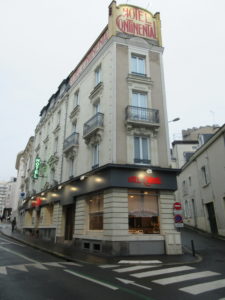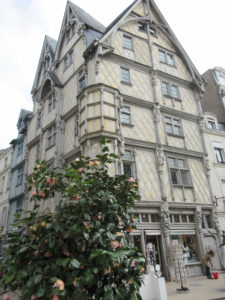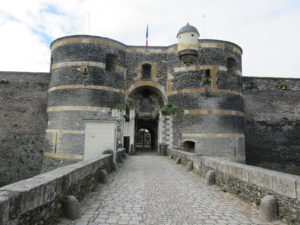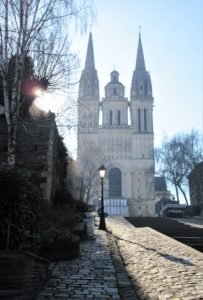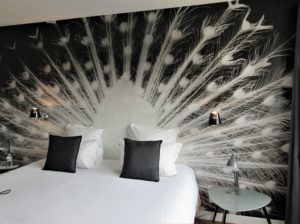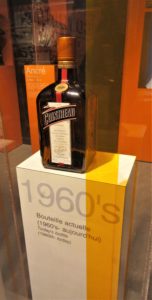We recently returned from a fantastic trip to Angers, a city in western France at the edge of the Loire valley and the medieval seat of the Plantagenet dynasty.
I had the good fortune of winning a prize from a well known supermarket, sponsored by Remy-Cointreau which included flights for 2 people to Nantes, transfers to Angers, accommodation, dinner, lunch and a personal tour of the Cointreau Distillery.
Having done some research on the city beforehand, we decided to spend 3 additional nights in Angers at our own expense so we could explore and enjoy the history and culture of the city, dominated by its remarkable castle and medieval structure with its narrow, winding streets and museums.
Arrangements were made by Cointreau representatives and my husband and I flew out from London, Gatwick on a 55 minute flight to Nantes in mid March. A taxi was waiting for us at the airport to transfer us to our hotel in Angers.
The first of our two nights were spent in The Continental Hotel, a rare type of building, built in the late 1890’s and sited in a good location in the city centre. The hotel exterior displays a monumental mosaic inscription, thought to be by the mosaic artist, Isidore Odorico. There is a multi-level, below ground parking lot approximately 50m from the front entrance of the hotel costing 2 euros for overnight stay. The tram is only a couple of steps away and is a great way to get around.
Le Continental has a free, closed, secure place for bicycles if required.
We received a friendly welcome when we arrived and were allocated room 101 a fair sized room overlooking a small, quiet back street.
The hotel has 25 air-conditioned rooms. We had a bathroom with shower, a shaver and hair dryer ( ‘2 pin’) points. WIFI is available with a password code. We had a TV and an alarm clock. A dry cleaning service is available for a fee, if required. A lift is available to rooms, all of which are non-smoking.
My only disappointment was no tea/coffee facility. The beds were very comfortable with nice, soft duvets. Breakfast was good – organic and local, costing 10 euros in the breakfast room which looked out onto the street.
This hotel is the first one in Angers to have obtained the European Ecolabel (protecting the environment)
On our first full day we visited the nearby Castle of Angers (Chateau’d Angers), with it’s impregnable royal fortress and 17 towers of shale and limestone. Built in the 13th century, it sits on a rocky promontory overlooking the River Maine.
We started by walking along the parapet where you get wonderful views from all angles. The field gateway was originally the main entrance and was composed of two broad towers with a complicated defensive system. The portcullis dates from 1370-1384 and is still in place today.
The Great Hall, Saint Laud Chapel, and archaeological zone with a sepulchral monument from the Neolithic period are all very interesting.
The one thing you must not miss is a masterpiece unique in the world – the 140m Tapestry of the Apocalypse. It was commissioned by Louis I, the Duke of Anjou in the late 1370s and is housed in an L shaped building erected in the 20th century. It took 7 years to make and is made entirely of wool.
Tucked away in number 17 tower is the place where the ‘raging mad’ were chained up in the 19th century when the site was used as an asylum. In another tower, graffiti can be seen on the stone when English sailors were locked up in the 18th century.
The Mill Tower once had a windmill on top and is the only tower to have retained its original height of about 40 metres ( other towers were levelled off).
Plantations include vines and a hanging garden planted with medicinal and aromatic species known in the Middle Ages. The castle has some remarkable gardens with boxwood and yew trees as well as a vegetable garden and rose garden.
If you don’t want a guided tour, you can on a go-as-you-please tour. There are adapted tours for disabled visitors. Adult entrance costs 9 euros and audio guides are available for 3 euros. It is 9 euros for an adult ticket, different rates for younger people and groups.
From the castle, we moved on to the ‘Fine Arts Museum’ (Musee des beaux Artes), and the Galerie David d’Angers. The oldest of the buildings is a 15th century private mansion known as the ‘Logis Barrault.’ The Renaissance architecture is home to fine art works with paintings ranging from the 14th to 20th century. After 5 years of refurbishing it is now quite spacious with 3000m of exhibition space. There are more than 500 artworks and archaeological objects, tracing Angers history from the Neolithic period to the present day.
This is a modern, visitor friendly museum and has a cafe restaurant using fresh produce. You can find a bookshop located in the lobby.
We crossed over the river Maine on our second day to the Musee Jean-Lurcat, housing beautiful contemporary tapestries. Here, Jean Lurcat made known his vision of the world, the Le Chant du Monde tapestry ( The Song of the World), depicting the dangers of our time.
The museum was once The Hospital Saint-Jean consisting of a group of well preserved buildings dating from the 12th century.
After sitting for a short while in the garden afterwards, we started to head back to the river and the Verdun Bridge.
On reaching the opposite side, back to the old part of the city, a long series of steps takes you up to the mid 12th century doorway of the Saint Maurice Cathedral with its 75m twin spires.
Some restoration is currently under way near the doorway. Saint Maurice is noted for its furnishings, tombstones and frescoes. In the 1980’s murals were discovered in the choir which had been hidden under whitewash in the 1700s. There are beautiful stain glass windows, particularly the South Rose Window of Christ which includes signs of the Zodiac.
Not far from the Cathedral, situated in the Sainte Croix Square, is one the oldest merchant roads of the town where you will find the Maison d’Adam (Adam’s House). This is the most exceptional of nearly 40 timber-framed houses still in Angers. It is a complex structure, with imposing dimensions, decorated with a series of sculptures, including the tree of life and a centaur of the ‘Tricouillard’ – a joker with his pants down and everything hanging out! Today, this five-storey house is home to a craft workshop with a gallery shop on the ground floor selling handcrafted glassware, sculptures and other artworks.
On the afternoon of our third day, we booked into 21 Foch, boutique hotel, our prize accommodation, just a couple of streets away from the centre/old town. This 19th-century hotel building is decorated in white and grey tones. Guest rooms and suites are accessed by a lift.
Our large room had a wonderful view overlooking the wide, imposing boulevard and tramway. We discovered a surprise, complementary Cointreau bar of chocolate and two miniature bottles of Cointreau waiting for us by a large TV set which was mounted in an ornate, white frame. The decor in the room was fabulous, along with a comfortable bed and seating. Although no tea/coffee facilities, we could make our own in a lounge area one floor down, near the restaurant area.
Dinner that evening had been arranged for us at 8 pm at the restaurant Le Dix Septieme. The restaurant was originally an historic 17th century former house located in the centre of the old town. We were greeted by Gaelle Cerini our charming hostess who introduced us to the amazing menu and different wines which accompanied each of our courses. Gaelle’s husband, Chef, Richard Cerini, certainly knows how to entice and delight people with his exciting and sophisticated cuisine
After enjoying an excellent, table served breakfast the following morning at 21 Foch, we were met by taxi at 10.15 for transfer to our highlight of the visit – The Cointreau Distillery.
Public Relations and Communication Officer, Valerie Quinaud-Cronier, was waiting to greet us for our personal, guided tour of the distillery and history of Cointreau.
Entering through the shop you find yourself surrounded by a ‘sea of orange’ with it’s shelves stacked full of the iconic Cointreau, square shaped bottles.
A subtle blend of peel from sweet and bitter oranges is the base of Cointreau’s secret recipe which we were about to discover. Passing through the doors of the distillery we encountered some sacks of dried peel. We were invited to take a piece of peel from a sample jar, snap, and smell. Wow – a heady orange scent suddenly bursts forth. A bitter peel from Brazil and Tunisia, a sweet peel from Senegal and Ghana and fresh peel in alcohol is the starting point of this unique liqueur process.
15 million bottles of Cointreau a year are produced here, with a high percentage of it’s export going to the USA. It has a 4 day distillation and 6-7000 bottles per hour are produced for one line. Working hours are from 8am to 4pm. This is increased when demand is high such as the Christmas period.
We walked through the copper stills, production and bottling areas and a long hall. It was most interesting to learn and discover the richness of Cointreau’s heritage through an incredible collection of the company’s advertising over the years and displays of historic, promotional bottles, glasses, awards, medals and diplomas.
Cointreau goes back to Edouard Cointreau when returning from the Franco Prussian War in 1870, had an idea to take on a new challenge. The Cointreau name had been associated in the previous 3 centuries with confectionery and cake making.
Liqueurs were becoming popular with consumers who began to want to try new things. Brothers, Edouard-Jean and Adolphe started to produce Guignolet, a 17th century cherry liqueur which had been almost forgotten about. Wild cherries were in abundance in the Anjou region, along with other fruits.
The first Cointreau distillery was opened at rue Saint-Laud, Angers in 1849. The family prospered with their cherry harvests and achieved success, selling mostly in their local area.
Edouard was a visionary and his character helped to transform the distillery and attract new and more demanding clientele. He observed that consumers appeared seduced by the exotic allure of orange, a scarce fruit at that time. Edouard saw the ‘orange’ as a universal flavour appealing to both men and women and began experimenting in his lab to produce a perfect balanced liqueur.
It took several years before he found the perfect combination. Once he did, the formula has stayed unchanged and it is still as popular today as it was then. Six generations later, the family still embrace the same passion and values as they did in the early days.
Our tour ended with a tasting session in the bar with cocktails and nibbles. The Barman, Thomas, shared his tricks and tips and even got me to make a cocktail, following his instructive guidance!
Just before leaving, Valerie presented me with a Cointreau bag filled with a book of the history of Cointreau, cocktail recipes and an interesting ‘spray bottle’ to add the seductive orange flavour to selective dishes – crepes, for example.
Expressing thanks and saying our goodbyes, we were collected by taxi and transferred to the Restaurant La Brassiere du Theatre in Angers were we enjoyed a fabulous lunch at Cointreau’s expense. Another, culinary experience!
The following day we were transferred back to Nantes airport for our return flight home after an extraordinary, unforgettable experience.
I can understand why Angers, has such a good reputation as a desirable and relaxing place to live. It’s culture, high quality of life, drivers who are respectful of others, a ‘feel safe’ factor, fine wines and cuisine – an ideal balance of city and nature.
Of course not to forget – the birthplace of the famous Cointreau liqueur which will forever leave a lasting memory.
